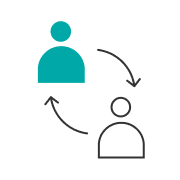
Education Powerhouse Quantifies User Happiness
Teach for All used Loop11 to uncover real UX insights and feedback that led to critical website improvements.
Understand user behavior on your website.
Test usability on mobile devices and tablets.
Conduct live, guided user testing sessions.
Design or refine your information architecture.
Allow users to test without assistance.
Understand visitors’ goals and satisfaction.
Determine which design performs better.
Analyze your website against competitors.
Optimize design before development.
Measure ease of finding your online properties.
Gain deeper insights using the power of AI.
Track users’ clicks and navigation patterns.
Visualize user engagement and interaction.
Capture user interactions for usability analysis.
Get access to all Loop11 features for free. Start free trial
Understand user behavior on your website.
Test usability on mobile devices and tablets.
Conduct live, guided user testing sessions.
Design or refine your information architecture.
Allow users to test without assistance.
Understand visitors’ goals and satisfaction.
Determine which design performs better.
Analyze your website against competitors.
Optimize design before development.
Measure ease of finding your online properties.
Gain deeper insights using the power of AI.
Track users’ clicks and navigation patterns.
Visualize user engagement and interaction.
Capture user interactions for usability analysis.

Real-time interaction with your users

Great for qualitative think-aloud studies

Test remotely from anywhere in the world

Loop11 offers user-friendly moderated testing features designed to help collect valuable insights and optimize your website or app. Here are four key advantages of using Loop11 for your moderated user testing:


Gain access to Loop11’s virtual observation room. Invite team members or stakeholders as observers during user sessions. This ensures that your team can actively observe the testing process without overwhelming the participant.

All moderated sessions can run for up to 2 hours in duration per participant. This allows you to thoroughly evaluate user experiences and gather comprehensive insights at your own pace.

Loop11 provides screen recording, webcam and face recording, and audio recording capabilities, allowing you to review participant sessions at a later stage. This allows you to rewatch key moments, share recordings with your team members and stakeholders, and foster collaboration based on the insights gained.

Once a testing session concludes, the video becomes instantly downloadable within the project’s report. This integration enables you to access and review the user sessions within minutes. Research teams can add, edit, and delete notes within the reporting to ensure your analysis is comprehensive and insightful.

Loop11 offers live access to participants’ screens on mobile, tablet, and desktop devices, enabling real-time interactions and time-stamped note-taking to capture critical study events.

Conduct user testing with participants from anywhere in the world. You can invite multiple observers to join testing sessions remotely. Each observer can actively contribute to note-taking and engage in live discussions with each other and the moderator through an built-in UI live chat.

Share essential notes and video clips with your team, highlighting the most valuable insights from the user tests. You can easily distribute this valuable information via Slack. Additionally, sharing via email is also available for added convenience.

Gain real-time insights and in-depth understanding of your users through interactive sessions and thought-provoking discussions.
Conducting moderated usability testing serves as an effective method to gather real-time insights and gain a deeper understanding of users’ motivations, frustrations, and actions. Here are the benefits of incorporating moderated usability testing into your user research process:

Remote moderated usability testing facilitates immediate feedback and discussion during the testing sessions, enabling clarification of user responses, probing for deeper insights, and addressing any questions or concerns on the spot.

Participants can engage in testing from their own environments, mirroring real-world scenarios. This authenticity provides researchers with accurate insights into user interactions, enhancing the reliability of feedback.

Remote moderated testing removes geographical barriers, allowing researchers to involve participants from diverse locations, demographics, and cultural backgrounds. This expands the validity and understanding of user experiences.

By eliminating the need for travel, remote moderated testing significantly reduces costs for both researchers and participants. Loop11 replicates the lab experience but online which offers a more affordable alternative without compromising the quality of insights obtained.

Remote moderated testing offers greater scheduling flexibility, enabling participants to choose time slots that suit their preferences. This improves recruitment, participation rates, and feedback diversity, while accommodating participants across different time zones.

Through real-time collaboration and observation in moderated testing, stakeholders can gain firsthand empathy with users, fostering shared understanding and enabling informed decision-making.


“Loop11 saves us a lot of time because we can reach more people than we could if we were doing in-person interviews.”


“Inviting stakeholders to watch the live sessions is super powerful because it helps them to empathize with users firsthand. We’re also able to put their assumptions to the test.”


“Loop11 has been easy to use from the parent and user standpoint, and easy for us on the back end to capture the video, download the video and manipulate what we need using the admin software that Loop11 provides to us.”

Explore our features that allow you to easily manage your testing projects and obtain valuable feedback from your users.
At Loop11, we help you unlock the power of comprehensive insights through moderated UX testing and generative research. We assist you in gathering a treasure trove of data, helping you make informed design decisions that can take your user experience to the next level.
Moderated user testing, or ‘Live Conversations’ in some platforms, involves an individual facilitating or moderating the study. This person, known as the moderator, works directly with test participants, guiding them through the research and answering their queries in real time. This form of user testing allows the product team to gain user insights, thus helping create more user-friendly products.
Why is moderated user testing so crucial? Well, picture this: as designers, we strive to make our products intuitive, effective, and irresistible. But how can we achieve this lofty goal without truly understanding our users? This is where moderated user testing shines bright like a guiding star. By conducting this enlightening process, we can gather qualitative data that illuminates the mysteries of our users' wants, needs, and desires. With this newfound knowledge, we can create a user experience that leaves our competitors in the dust.
Moderated user testing isn't just some ordinary feedback-gathering method—it's a superhero in disguise. Imagine having the power to enhance feedback loops and refine your designs to near perfection. That's right, moderated user testing allows you to harness this superpower. By inviting real users to interact with your product under the watchful eye of a skilled moderator, you open the floodgates of valuable feedback. This invaluable input fuels your design process, empowering you to craft more intuitive, effective, and downright game-changing products.
In moderated testing, a skilled moderator plays a pivotal role in engaging with test participants and guiding them through various tasks, making it an effective method for evaluating usability. This approach is useful under the following circumstances, where additional context and support are needed:
In-depth user experience analysis:
Moderated testing offers the advantage of gaining a profound understanding of the user's experience. By actively interacting with your participants, the moderator can ask probing questions and delve deeper into their thoughts and behaviors. This allows for observing usability issues that might not be readily observable.
Evaluation of prototypes or early-stage products:
When assessing a prototype or an early product version, having a moderator present becomes highly beneficial. The moderator can address inquiries and provide immediate feedback on the product's usability, allowing for timely improvements and adjustments to enhance the user experience.
Tackling complex or challenging tasks:
Testing tasks that are intricate or demanding can benefit greatly from the presence of a moderator. The moderator plays a crucial role in assisting participants in comprehending the task requirements and overcoming any obstacles they may encounter. Their guidance and support provide more accurate insights into the user's ability to navigate complex scenarios.
There are two types of moderated user testing: Remote Moderated Usability Testing and In-Person Usability Testing. With a moderator at your disposal, you've got the ultimate usability consultant on standby. They're there to answer burning questions, provide real-time feedback, and help you fine-tune your product's usability.
What is Remote Moderated Usability Testing?
Remote moderated usability testing is a method of conducting usability tests using online software tools or custom testing applications. This approach eliminates the limitations imposed by physical location, allowing researchers to interact with participants remotely. This has been very useful during the pandemic when everyone works from home, restricted by lockdowns and travel regulations.
For example, imagine this scenario where you recently participated in a remote moderated usability test. You were asked to download a mobile app designed specifically for the test. The researcher could see and communicate with you through its video call-based interface as you navigate the test stages, like with late-stage Figma prototype designs.
What is In-Person Moderated Usability Testing?
In contrast, in-person moderated usability testing involves inviting participants to a physical testing center, an office space, or any mutually agreed-upon location. During an in-person test, the moderator can observe participants' body language and establish rapport, which can foster open and honest communication.
Loop11 is designed for remote user testing however it can be used for in-person user testing also.
Moderated user testing can be conducted remotely or in person, offering flexibility to meet different needs. Remote moderated user testing has become increasingly popular, particularly with the rise of remote work setups. It offers cost-effectiveness and time efficiency by eliminating travel expenses and logistical challenges. Participants can engage in the test from the comfort of their own homes or offices. However, it's important to note that remote testing may come with potential technical issues and internet connectivity problems, which can occasionally delay the study.
On the other hand, in-person testing provides a controlled environment with fewer distractions, ensuring a more focused study. The moderator can closely observe participants' reactions, body language, and non-verbal cues, which can provide valuable insights into their user experience. However, in-person testing may require more logistical arrangements, such as scheduling participants to visit a specific location.
Ultimately, the choice between remote and in-person moderated usability testing depends on factors like the nature of the study, the target audience, and available resources. Both approaches have their advantages and disadvantages. You should carefully evaluate which method best aligns with your goals.
So, you're embarking on a usability testing path to gather valuable insights and enhance your product's user experience. But where do you begin?
Let's consider a few key factors that will shape your testing approach, and here are nine steps to help you conduct an effective moderated usability test aimed at evaluating user experiences, gathering feedback, and improving the design of products and services:
Step 1: Define Test Objectives
Begin by clearly defining the objectives of your usability test. What specific aspects of the product or service do you want to evaluate? For example, if you are testing an e-commerce website, your goal is to assess the efficiency of the checkout process and the intuitiveness of navigation.
Step 2: Identify Target Participants
Determine the target user group for your usability test. Consider the demographics, experience level, and any other relevant factors. If you are testing a mobile fitness-tracking app, your target participants regularly engage in physical activities and are comfortable using smartphones.
Step 3: Prepare Test Tasks and Scenarios
Create realistic tasks and scenarios that participants will perform during the test. These tasks should reflect real-world scenarios and cover the objectives you defined in Step 1. For example, if you are testing a food delivery app, a task could be to order a specific meal and track its delivery progress.
Step 4: Design Test Materials and Protocols
Prepare the necessary materials for the test, such as a prototype, wireframes, or a functional product. Develop a moderator's guide, which includes instructions for each task, probing questions, and areas of interest. This guide will help ensure consistency across sessions. For instance, the moderator's guide might instruct the facilitator to ask participants about their thoughts on the menu layout and how easily they can find specific dishes.
Step 5: Recruit Participants
Recruit participants who match your target user group. This can be done through various means, such as online user testing platforms, social media, or in-person hire. Ensure you have a diverse sample to capture a range of user perspectives and behaviors.
Step 6: Conduct the Test Sessions
During the test sessions, welcome participants, establish rapport and explain the purpose and procedure of the test. Encourage them to think aloud as they complete tasks, expressing their thoughts, concerns, and feedback. Observe their interactions with the product closely. If a participant hesitates while searching for a specific feature, note their behavior and ask follow-up questions about their experience.
Step 7: Document Observations and Feedback
Take detailed notes of participant behavior, verbal feedback, and any usability issues encountered. Capture both positive and negative feedback, including suggestions for improvement. For example, if a participant praises the app's quick and easy registration process, note it as a positive observation.
Step 8: Analyze Data and Identify Patterns
Review the notes, audio/video recordings, and other data collected during the test sessions. Look for patterns, common usability issues, and areas where participants struggled or excelled. This analysis will help identify key insights and inform design decisions.
Step 9: Create a Usability Test Report
Remember to summarize the findings and insights from the usability test in a comprehensive report. Include a brief overview, objectives, methodology, key observations, and recommendations for improvement. Use visuals, such as charts or screenshots, to support your findings.
By following these steps, you can conduct a well-structured moderated usability test study that aims to understand user intent, gather valuable insights into user behavior and motivations, and identify areas for improvement. This study will contribute to enhancing the user experience on your website by informing the development of user-centered design solutions.
Moderated usability testing involves two primary types of data analysis: quantitative and qualitative. These analyses provide insights into the results of the testing sessions, aiding in identifying usability issues and understanding user experiences more comprehensively.
Quantitative data analysis examines the data collected during the testing, such as task completion time, error rates, and participant satisfaction. This analysis allows for the identification of specific usability issues that require attention.
On the other hand, qualitative data analysis involves studying the qualitative data gathered during the testing, such as participant comments and feedback. This analysis provides a deeper understanding of the user's experience and helps uncover the underlying causes of usability issues.
To conduct a thorough analysis of moderated usability testing results, several quantitative and qualitative techniques can be employed:
Quantitative Data Analysis Techniques:
Qualitative Data Analysis Techniques:
It is best to combine quantitative and qualitative data analysis techniques to effectively analyze moderated usability testing results. This approach provides a comprehensive understanding of the identified usability issues.
To analyze the results of moderated usability testing effectively, consider the following tips:
By following these tips, you can ensure that the results of your moderated usability testing are thoroughly analyzed, leading to effective improvements in the usability of your product.
Moderated user testing is most effective when integrated into the initial phases of the development process. Specifically, moderated testing can be a valuable tool for conducting exploratory research during the prototyping stage. Even with basic sketches and wireframes, gathering user feedback on prospective design ideas is possible.
This early input is crucial in avoiding the creation of a product that users may need help comprehending. By leveraging moderated testing at this stage, developers can gather insights that guide the design and development process, ensuring the end product meets user expectations and requirements.
To ensure the ideal scenario for moderated user testing, it is crucial to consider the following factors:
Quantitative Data Analysis Techniques:
In addition to these factors, the ideal scenario for conducting moderated user testing would also involve the following:

Teach for All used Loop11 to uncover real UX insights and feedback that led to critical website improvements.

Research depends on feedback from the intended or current product users. Identifying and including all key niche audiences in research studies is a must.

Experience design has been getting traction as a result of the realization that every interaction with a brand tells a story. Whether you actively invest in shaping those interactions or not, they are happening and are influencing how customers perceive your brand. Experience design is a holistic approach that covers the entire customer journey and […]
Start a moderated usability test today and unlock the power of understanding your users on a deeper level with Loop11.

We love sharing interesting UX topics and work by creatives out there. Follow us for weekly UX posts, inspirations and reels!